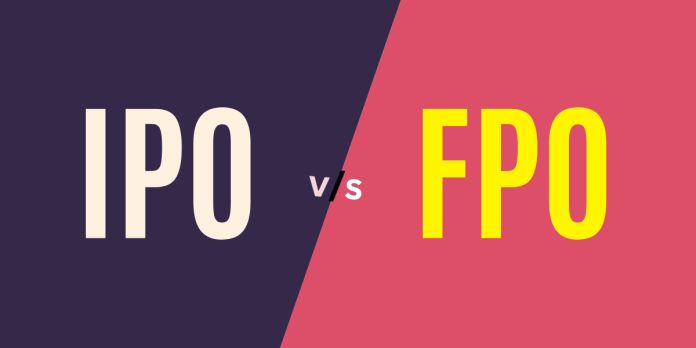The world of finance is replete with acronyms and technical jargon, and two such terms that often make headlines are IPO and FPO. Both IPO (Initial Public Offering) and FPO (Follow-on Public Offering) are methods through which companies raise capital by offering shares to the public. However, they serve different purposes and have distinct characteristics. In this blog, we’ll delve into the differences between IPO and FPO to help you better understand these important financial concepts.
Purpose
- IPO (Initial Public Offering): An IPO is the first time a company offers its shares to the public. It is the initial step to transition from a privately held company to a publicly traded one. The primary goal of an IPO is to raise capital for various purposes, such as expansion, debt reduction, or funding research and development.
- FPO (Follow-on Public Offering): An FPO, on the other hand, is a secondary offering of shares by a company that is already publicly traded. FPOs are typically used to raise additional capital after the company’s IPO. The funds generated through an FPO can be used for various reasons, including further expansion, debt reduction, or even the acquisition of other companies.
Timing
- IPO (Initial Public Offering): An IPO happens when a private company decides to go public. It is a one-time event, marking the company’s initial entry into the stock market.
- FPO (Follow-on Public Offering): An FPO occurs after a company has already conducted its IPO and is trading on a stock exchange. It can happen multiple times during a company’s lifetime, depending on its need for additional capital.
Process
- IPO (Initial Public Offering): Going public through an IPO involves several stages. The company appoints underwriters, files a prospectus with the Securities and Exchange Board of India (SEBI), conducts roadshows to attract investors, and sets the IPO price. Once the shares are offered to the public, the company’s stock is listed on a stock exchange, and it becomes available for trading.
- FPO (Follow-on Public Offering): The process for an FPO is typically less complex than an IPO. The company files a prospectus or an offer document, but the process may be less intensive since the company is already public. The new shares are offered to the existing shareholders and the general public at the current market price, or at a discount.
Investor Base
- IPO (Initial Public Offering): During an IPO, a company’s shares are offered to the general public for the first time. It attracts a broader range of investors, including institutional investors, retail investors, and the company’s employees.
- FPO (Follow-on Public Offering): In an FPO, shares are typically offered to existing shareholders and new investors. Existing shareholders may exercise their right to purchase more shares, and new investors can participate as well.
Ownership and Control
- IPO (Initial Public Offering): An IPO typically dilutes the ownership of existing shareholders, including the company’s founders and early investors. The company may also face greater scrutiny from public shareholders and regulatory bodies.
- FPO (Follow-on Public Offering): An FPO may dilute existing shareholders to a lesser extent, as the offering is usually smaller in scale. Existing shareholders, particularly large institutional investors, may retain more control.
Pricing
- IPO (Initial Public Offering): IPO prices are often set through a combination of valuation methods, investor demand, and market conditions. The goal is to strike a balance between maximizing capital raised and ensuring the shares are attractive to investors.
- FPO (Follow-on Public Offering): In an FPO, shares are typically priced based on the prevailing market conditions. The company may offer shares at the current market price or a slight discount to incentivize investors.
Risks and Rewards
- IPO (Initial Public Offering): Investing in an IPO can be riskier, as it involves buying shares in a company with no prior trading history. However, it can also offer the potential for significant rewards if the company performs well post-IPO.
- FPO (Follow-on Public Offering): FPOs are generally considered lower risk since the company is already established in the market. However, the potential for significant returns may be lower compared to an IPO.
Read: Understanding RHP and DRHP
In conclusion, IPOs and FPOs serve different purposes in the world of finance. IPOs are the gateway to the stock market for private companies, while FPOs are a means for public companies to raise additional capital. Understanding the differences between these two methods is crucial for investors and companies alike, as it can help them make informed decisions regarding capital raising and investment opportunities. Each method has its own set of advantages and risks, and the choice between an IPO or FPO depends on the company’s financial needs and objectives.
Disclaimer: This blog has been written exclusively for educational purposes. The securities mentioned are only examples and not recommendations. It is based on several secondary sources on the internet and is subject to changes. Please consult an expert before making related decisions.


